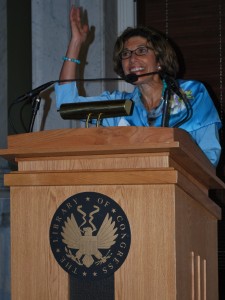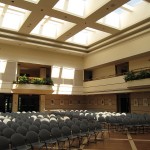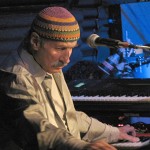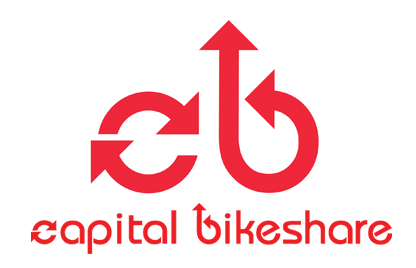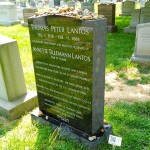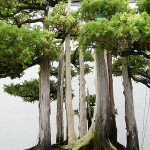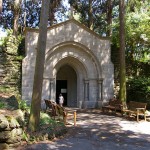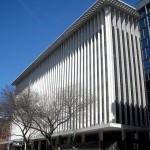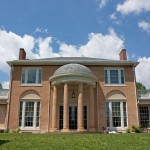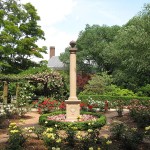Digging into ArtBytes
Posted by LisaMarrs on July 30th, 2012
Down Charles Street in Baltimore, Maryland sits a museum basking in the hot summer sun like a contented cat, right across from the gloriously green, statue-populated, and many-fountained grounds of Johns Hopkins University. Within the museum’s cool, white marble halls and rooms rest thousands of art treasures, from ancient American statues to canvasses from the mid-1900s. This is the Walters Art Museum, completely free to the public, and the site of ArtBytes, a hackathon that debuted the weekend of July 27, 2012.
Hackers from as far away as New York came together with museum staff to figure out how to better the museum experience in a competitive, yet collaborative atmosphere. The teams worked through the weekend and most of them arrived at the ending presentations with nearly completed, if still rough, products. There was team Time Machine’s mobile app that could recognize a work of art and then show that work’s original color or an xray of that work depending on the images and information the museum has in storage. Team Pez-Head created a way to do 3D modeling of sculptures and then print them out in rather excellent detail to make art more accessible by making it “touchable”. Both Team Schrodd0n and WalTours made different kinds of maps for mobile devices for the Walters Art Museum to help visitors navigate exhibits. Dave Raynes, a team of one, worked on making the data shored up in the Walters databases more easily available to software, which was a great help to many other groups. Badgify the Walters was all about putting up QR codes around the museum for kids to find and scan to collect points by doing quizzes on the art works which would eventually culminate in collecting badges on a profile online.
Although all groups ‘won’ the competition and each received $500, the judges managed to pick out two favorites to shower $1000 on. The first was
“Put Art in its Frame,” a mobile application where you can choose what time period the exhibit is in and then see all the significant world events that happened during that time period. The second was “Tanzaku,” a mobile application taking from the Japanese idea of writing notes on strips of paper (tanzaku) and hanging them up for all to see, which is an idea already in effect in the Hashiguchi Goyo “Beautiful Women” exhibit, where visitors write their own tanzaku and put them up on wires. The mobile app is a way to leave comments on art pieces and exhibits, as well as on the museum itself, with the potential to be connected to various social networking sites. All of this provides a way to potentially go on a tour with absent friends and explore how various pieces of art have touched different people.
So many amazing projects came out of this hackathon, sprung from the creative minds and intense will of their creators. Tapping into this pool of talented people, the Walters Art Museum ultimately benefited, providing an example other Galleries, Libraries, Archives and Museums may follow. The museum is not only enterprising in terms of calling forth capable people to use their talents and grow new abilities, but it also furthers its own goals by tapping into existing projects such as Wiki Loves Monuments, an event coming up in September where people all over the globe will sally forth to take pictures of public objects of historic and/or artistic value and upload those pictures onto Wikimedia Commons, both to increase the stock of public domain photos and to enter their photos in a contest. The Walters’ Wiki Loves Monuments is accepting pictures now of public artworks all over Baltimore as an extension of their Public Property exhibit (although note that only pictures submitted to Commons during the month of September are eligible for the worldwide contest).
Lisa Marrs, Outreach & Program Coordination, Wikimedia DC
Down Charles Street in Baltimore, Maryland sits a museum basking in the hot summer sun like a contented cat, right across from the gloriously green, statue-populated, and many-fountained grounds of Johns Hopkins University. Within the museum’s cool, white marble halls and rooms rest thousands of art treasures, from ancient American statues to canvasses from the mid-1900s. This is the Walters Art Museum, completely free to the public, and the site of ArtBytes, a hackathon that debuted the weekend of July 27, 2012.
Hackers from as far away as New York came together with museum staff to figure out how to better the museum experience in a competitive, yet collaborative atmosphere. The teams worked through the weekend and most of them arrived at the ending presentations with nearly completed, if still rough, products. There was team Time Machine’s mobile app that could recognize a work of art and then show that work’s original color or an xray of that work depending on the images and information the museum has in storage. Team Pez-Head created a way to do 3D modeling of sculptures and then print them out in rather excellent detail to make art more accessible by making it “touchable”. Both Team Schrodd0n and WalTours made different kinds of maps for mobile devices for the Walters Art Museum to help visitors navigate exhibits. Dave Raynes, a team of one, worked on making the data shored up in the Walters databases more easily available to software, which was a great help to many other groups. Badgify the Walters was all about putting up QR codes around the museum for kids to find and scan to collect points by doing quizzes on the art works which would eventually culminate in collecting badges on a profile online.
Although all groups ‘won’ the competition and each received $500, the judges managed to pick out two favorites to shower $1000 on. The first was
“Put Art in its Frame,” a mobile application where you can choose what time period the exhibit is in and then see all the significant world events that happened during that time period. The second was “Tanzaku,” a mobile application taking from the Japanese idea of writing notes on strips of paper (tanzaku) and hanging them up for all to see, which is an idea already in effect in the Hashiguchi Goyo “Beautiful Women” exhibit, where visitors write their own tanzaku and put them up on wires. The mobile app is a way to leave comments on art pieces and exhibits, as well as on the museum itself, with the potential to be connected to various social networking sites. All of this provides a way to potentially go on a tour with absent friends and explore how various pieces of art have touched different people.
So many amazing projects came out of this hackathon, sprung from the creative minds and intense will of their creators. Tapping into this pool of talented people, the Walters Art Museum ultimately benefited, providing an example other Galleries, Libraries, Archives and Museums may follow. The museum is not only enterprising in terms of calling forth capable people to use their talents and grow new abilities, but it also furthers its own goals by tapping into existing projects such as Wiki Loves Monuments, an event coming up in September where people all over the globe will sally forth to take pictures of public objects of historic and/or artistic value and upload those pictures onto Wikimedia Commons, both to increase the stock of public domain photos and to enter their photos in a contest. The Walters’ Wiki Loves Monuments is accepting pictures now of public artworks all over Baltimore as an extension of their Public Property exhibit (although note that only pictures submitted to Commons during the month of September are eligible for the worldwide contest).
Lisa Marrs, Outreach & Program Coordination, Wikimedia DC
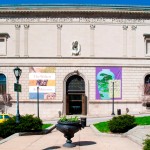
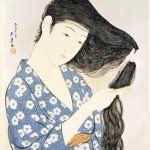
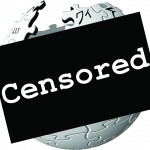
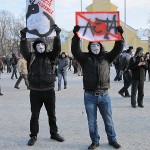

 Wikimania 2012
Wikimania 2012